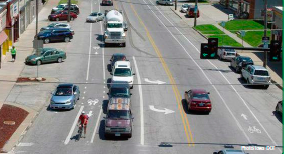TEMPORARY ROAD DIET BECOMES PERMANENT
| Objective | Features | Results |
|---|---|---|
|
|
|


BACKGROUND
In 2010, the City of Des Moines, decided to "try out" a Road Diet on 4-lane Ingersoll Avenue between Polk Boulevard and Martin Luther King Jr. Parkway for a trial period. The 2-mile long Road Diet was implemented primarily as a Context Sensitive Solution (CSS) project to enhance the business environment with traffic calming, improve pedestrian and bicycle access, and add landscaping.
We were critical of the Des Moines City Council for its decision to approve the restriping of Ingersoll Avenue to change it from four lanes to three lanes...On all accounts, we were wrong. Our concerns proved to be unwarranted.
Cityview, Central Iowa's Independent Weekly1
Carrying 11,000 to 17,000 vehicles per day and serving as a transit bus route, Ingersoll Avenue is primarily developed with small, locally owned retail stores and restaurants. After the completion of the Road Diet, the final cross section included a 3-lane roadway with parking and bicycle lanes in both directions. The city provided right-turn lanes at the signalized intersections by prohibiting parking prior to the traffic signal.

COMMUNITY CONCERNS
The community initially expressed concerns about a potential Road Diet, mostly centered on reducing traffic lanes to accommodate bicyclists. Critics were worried the Road Diet would cause more congestion, thereby encouraging motorists to avoid the area and hurting the businesses along Ingersoll. The community was also worried the change could result in an increase in crashes. The city's response was to offer a 6-month trial period for the Road Diet. If the public's concerns came to fruition, then the city would happily convert Ingersoll back to a 4-lane roadway.
RESULTS
Six months after the conversion, no major traffic problems had developed during the Ingersoll Avenue Road Diet. Although the Road Diet was not initially proposed and promoted as a safety improvement project, a simple before-and-after crash study revealed a 50 percent reduction in crashes.
Overall, traffic volumes did not decrease. In fact, there was a 5 percent increase in traffic from 11:00 AM to 1:00 PM, which suggests that motorists found the Ingersoll corridor to be more comfortable and inviting during their lunchtime.
The city conducted an online survey to gauge the public's view of the Road Diet after implementation. Although there remained some opposition, the results revealed that fewer people opposed the project after implementation than when the project was first proposed, and a majority favored keeping the Road Diet and felt the road was safer.
As a result of these findings, the Des Moines City Council voted to retain the Ingersoll Avenue Road Diet.
1 Editorial Page, "Our View: Road diet makes Ingersoll fit" Cityview, Central Iowa's Independent Weekly, November 18, 2010. Accessed March 17, 2015. Available at: http://dmcityview.com/2010/11/18/columns/ourview.html.
